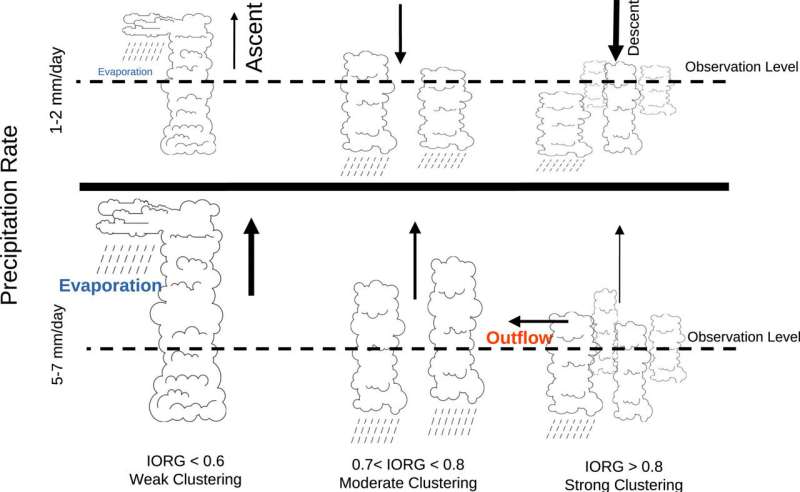This article has been reviewed according to Science X's editorial process and policies. Editors have highlighted the following attributes while ensuring the content's credibility:
fact-checked
peer-reviewed publication
trusted source
proofread
Thunderstorms clumping together: How understanding water vapor helps scientists predict future climate change

A team of international scientists from the U.S., France, Germany, and Ethiopia recently published cutting-edge climate research on how thunderstorms can "clump" together and how that influences the Earth's climate. This led to the discovery that this clumping, or aggregation, of clouds can affect the Earth's climate in multiple ways that were not previously understood.
The research, titled "The Influence of Convective Aggregation on the Stable Isotopic Composition of Water Vapor," was recently published in AGU Advances.
"It's a new group of datasets, and this was the first time we were able to bring all these different techniques to bear on the interesting problem of how clouds clump together and how that clumping can affect climate," said University of New Mexico's Department Earth & Planetary Sciences Professor Joseph Galewsky. This research was conducted while Galewsky was on sabbatical in France at the Laboratoire de Météorologie Dynamique (LMD) in Paris.
The idea that thunderstorms can aggregate has been known for decades, but the impacts on water vapor and the use of stable isotopes in water vapor to track these processes are quite new. There is evidence that the clumping of clouds has a surprisingly large impact on climate.
In this research, the team of international scientists used remote sensing data to investigate how the organization of clouds affects the chemistry of water vapor in the atmosphere. These clouds can range from individual cells to larger systems like tropical cyclones. The study focused on the global tropics from 2015 to 2020.
One of the key discoveries of the research was that cloud organization impacts the distribution of water vapor in the atmosphere. They found that when clouds are not organized (unaggregated), the atmosphere tends to have more moisture but that the water vapor is relatively depleted in deuterium, a heavy isotope of hydrogen. This suggests that evaporation from rain contributes to this pattern.
"Water vapor itself is a greenhouse gas, actually the most important greenhouse gas, and the stable isotopes in water vapor help us to track the processes that govern the distribution of water vapor. What we found was that in regions where thunderstorms are not organized, meaning that the clouds are isolated and look sort of like popcorn, the atmosphere tends to be quite moist," said Galewsky.
In cases of organized (aggregated) convection, there is less moisture in the atmosphere, but the water vapor is more enriched in deuterium. This implies more transport of water vapor from near the Earth's surface into the upper parts of the atmosphere.
"When the clouds are very tightly bundled together, the atmosphere tends to be a lot drier and the water vapor is more is more isotopically enriched, meaning that there's water vapor coming from the boundary layer, the lowest parts of the atmosphere, into the middle atmosphere," Galewsky explained.
Lastly, they discovered that when convective clouds are moderately organized (intermediate aggregation), there is no significant variation in water vapor isotopic composition.
"It gives insight into how this clumping of storms affects the current climate through radiative processes linked to variations in humidity. It also potentially helps us to better understand past climates because the isotopes in water vapor are often recorded in things like cave formations or ice cores," Galewsky said.
The findings may help in the interpretation of paleoclimate records because past changes in convective cloud organization could lead to isotopic signals that have not been recognized in past research. This is vital for understanding ancient climate variations.
"What we found is that the way these clouds are organized can have a big impact on water vapor in the atmosphere. And that is important because it can influence how the earth is able to cool itself off, which has obvious implications for climate change," said Galewsky.
This research helps bridge the gap between theoretical models and real-world observations, allowing the researchers to better understand the complex interactions within the atmosphere. "People who've been studying convective aggregation have been calling for isotope studies for a long time, and we were the first group to actually be able to pull it off," said Galewsky. This will help provide better observational constraints for climate models. The results of this research can help provide new ways for climate modelers to test that their models are working correctly.
"The atmosphere is currently warming, and the evidence is overwhelming that that's due to the burning of fossil fuels. And while the basic physics of climate change is very well understood and has been well understood for more than a century at this point, there are a lot of details that we still don't understand well; in particular, probably the biggest uncertainty in our projection of future climate has to do with clouds and how they affect climate," explained Galewsky,
"This is a new way of trying to get at this most important uncertainty in climate projections for the future and for New Mexico. This research will help to better constrain those future studies."
More information: Joseph Galewsky et al, The Influence of Convective Aggregation on the Stable Isotopic Composition of Water Vapor, AGU Advances (2023). DOI: 10.1029/2023AV000877
Journal information: AGU Advances
Provided by University of New Mexico




















